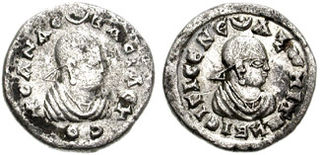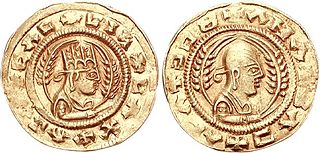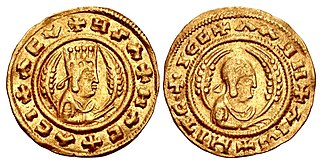Related Research Articles

Gudit is the Classical Ethiopic name for a personage also known as Yodit in Tigrinya, and Amharic, but also Isato in Amharic, and Ga'wa in Ţilţal. The person behind these various alternative names is portrayed as a powerful female ruler, probably identical to Māsobā Wārq, the daughter of the last Aksumite king, Dil Na'ad, mentioned in an early Arabic source. She is said to have been responsible for laying waste the Kingdom of Aksum and its countryside, and the destruction of its churches and monuments in the 10th century AD in revenge for the church having cut her breast off and selling her into slavery. If she is the same as the Tirda' Gābāz in other Ethiopian sources, she is also said to have attempted to exterminate the members of the ruling dynasty. The deeds attributed to her are recorded in oral tradition and in a variety of historical narratives.

Axum, also spelled Aksum, is a town in the Tigray Region of Ethiopia with a population of 66,900 residents. It is the site of the historic capital of the Aksumite Empire.

Ezana, was the ruler of the Kingdom of Aksum. One of the best-documented rulers of Aksum, Ezana is important as he is the country's first king to embrace Christianity and make it the official religion. Tradition states that Ezana succeeded his father Ella Amida (Ousanas) as king while still a child but his mother, Sofya then served as regent until he came of age.

Kaleb, also known as Saint Elesbaan, was King of Aksum, which was situated in modern-day Ethiopia and Eritrea

Ousanas was a King of Axum. Stuart Munro-Hay believes that it is "very likely" that Ousanas is the king to whom Aedesius and Frumentius were brought. In Eritrean and Ethiopian tradition, this king is called Ella Allada or Ella Amida. Ella Amida would then be his throne name, although Ousanas is the name that appears on his coins. If this identification is correct, then it was during his reign that Christianity was introduced to Axum and the surrounding territories.

Sembrouthes was a King of the Kingdom of Aksum who most likely reigned sometime in the 3rd century. He is known only from a single inscription in Ancient Greek that was found at Dekemhare, Hamasien in modern-day Eritrea, which is dated to his 24th regnal year. Sembrouthes was the first known ruler in the lands later ruled by the Emperor of Ethiopia to adopt the title "King of Kings". He is a probable candidate for the king who erected the Monumentum Adulitanum.

Endubis or Endybis was a late-3rd-century sovereign of the Kingdom of Aksum in East Africa. He was among the earliest rulers in the Africa to mint his own coins; according to Stuart C. Munro-Hay, "No other sub-Saharan African state issued its own independent coinage in ancient times -- indeed no other African state at all, since those in North Africa fell under Roman dominion." The Aksumite currency of his reign was issued in gold, silver, and bronze or copper denominations and bore inscriptions in Koine Greek.

Ouazebas was a King of the Kingdom of Aksum. He is primarily known through the coins that were minted during his reign.

Eon was a King of the Kingdom of Aksum. He is primarily known through the coins minted during his reign, where his name is written in Greek as "Eon Bisi Anaaph". Only his coins issued in gold are known; many new examples were identified in the al-Madhariba hoard found in Yemen.

Ebana was a 5th-century King of the Kingdom of Axum. He is primarily known from the series of coins that were minted during his reign. His gold coins "are easily the commonest of Aksumite gold issues".

Gersem was a King of the Kingdom of Aksum in Northeast Africa. He is primarily known through the Aksumite currency that was minted during his reign.
Habesha peoples is an ethnic or pan-ethnic identifier that has been historically employed to refer to Semitic speaking and predominantly Oriental Orthodox Christian peoples found in the highlands of Ethiopia and Eritrea between Asmara and Addis Ababa and this usage remains common today. The term is also used in varying degrees of inclusion and exclusion of other groups.

Aksumite currency was coinage produced and used within the Kingdom of Aksum centered in present-day Eritrea and Ethiopia. Its mintages were issued and circulated from the reign of King Endubis around AD 270 until it began its decline in the first half of the 7th century where they started using Dinar along with most parts of the Middle East. During the succeeding medieval period, Mogadishu currency, minted by the Sultanate of Mogadishu, was the most widely circulated currency in the eastern and southern parts of the Horn of Africa from the start of the 12th century.
The terms African civilizations, also classical African civilizations, or African empires are terms that generally refer to the various pre-colonial African kingdoms. The civilizations usually include Egypt, Carthage, Axum, Numidia, and Nubia, but may also be extended to the prehistoric Land of Punt and others: Kingdom of Dagbon, the Empire of Ashanti, Kingdom of Kongo, Empire of Mali, Kingdom of Zimbabwe, Songhai Empire, the Garamantes the Empire of Ghana, Bono state, Harla Kingdom and Kingdom of Benin.

The Ezana Stone is an ancient stele still standing in modern-day Axum in Ethiopia, the centre of the ancient Kingdom of Aksum. This stone monument, that probably dates from the 4th century of the Christian era, documents the conversion of King Ezana to Christianity and his conquest of various neighbouring areas, including Meroë.

Ethiopia is one of the oldest countries in Africa; the emergence of Ethiopian civilization dates back thousands of years. Abyssinia or rather "Ze Etiyopia" was ruled by the Semitic Abyssinians (Habesha) composed mainly of the Amhara, Tigrayans and the Cushitic Agaw. In the Eastern escarpment of the Ethiopian highlands and more so the lowlands was the home of the Harari/Harla that founded Sultanates such as Ifat and Adal and the Afars. In the central and south were found the ancient Sidama and Semitic Gurage, among others.

The Kingdom of Aksum, also known as the Kingdom of Axum, or the Aksumite Empire, was a kingdom in East Africa and South Arabia from Classical antiquity to the Middle Ages. Based in what is now Northern Ethiopia and Eritrea, and spanning present day Djibouti and Sudan, it extended at its height into much of Southern Arabia during the reign of Kaleb, King of Axum.

Wukro Chirkos is an Orthodox Tewahedo monolithic church located in northern Ethiopia, on the northern edge of the town of Wukro near the main highway. From the time members of the 1868 British Expedition to Abyssinia reported its existence until the early 20th century, it was the only rock-hewn church known to the outside world.
Sofya (4th-century), was a queen consort and regent of the Kingdom of Axum.
Regnal lists of Ethiopia are recorded lists of monarchs who are claimed by tradition to have ruled Ethiopia. These lists are often recorded on manuscripts or orally by monasteries and have been passed down over the centuries.
References
- 1 2 Hein, Ewald (1999). Ethiopia, Christian Africa : art, churches and culture. Ratingen : Melina-Verlag. pp. 99–100. ISBN 978-3-929255-28-7.
- ↑ Prouty, Chris (1981). Historical dictionary of Ethiopia. Metuchen, N.J. : Scarecrow Press. p. 1. ISBN 978-0-8108-1448-6.
- ↑ Heldman, Marilyn Eiseman (1993). African Zion: the sacred art of Ethiopia. New Haven ; London : Yale University Press. p. 71. ISBN 978-0-300-05819-2.
- 1 2 3 4 Munro-Hay, Stuart (1991). Aksum: An African Civilisation of Late Antiquity. United Kingdom: Edinburgh University Press. pp. 13 and 205–206. ISBN 0-7486-0106-6.
- ↑ Munro-Hay, Stuart C (2002). Ethiopia, the unknown land : a cultural and historical guide. London ; New York : I.B. Tauris. p. 146. ISBN 978-1-86064-744-4.
- ↑ Plant, Ruth (1985). Architecture of the Tigre, Ethiopia. Worcester: Ravens Educational & Development Services Ltd. p. 95. ISBN 0-947895-00-0.